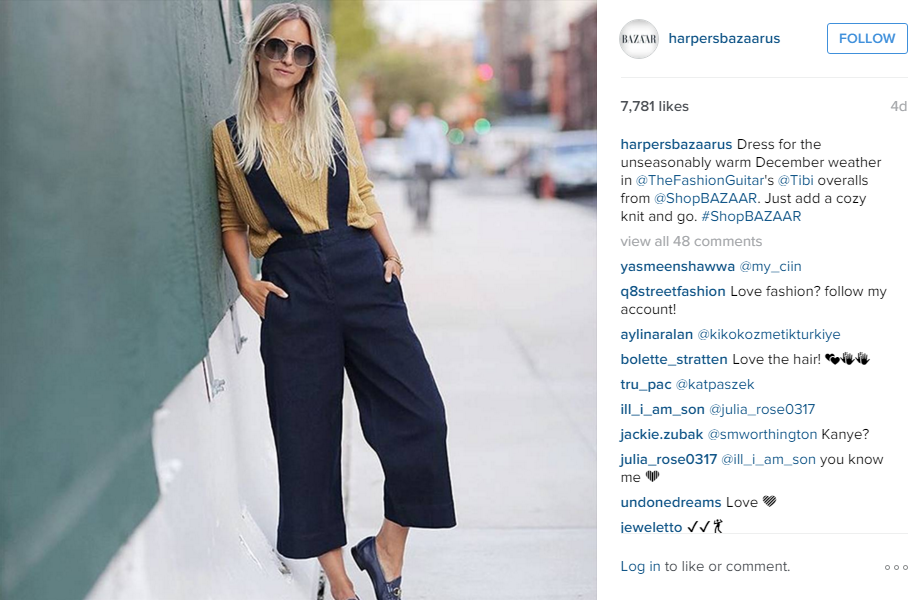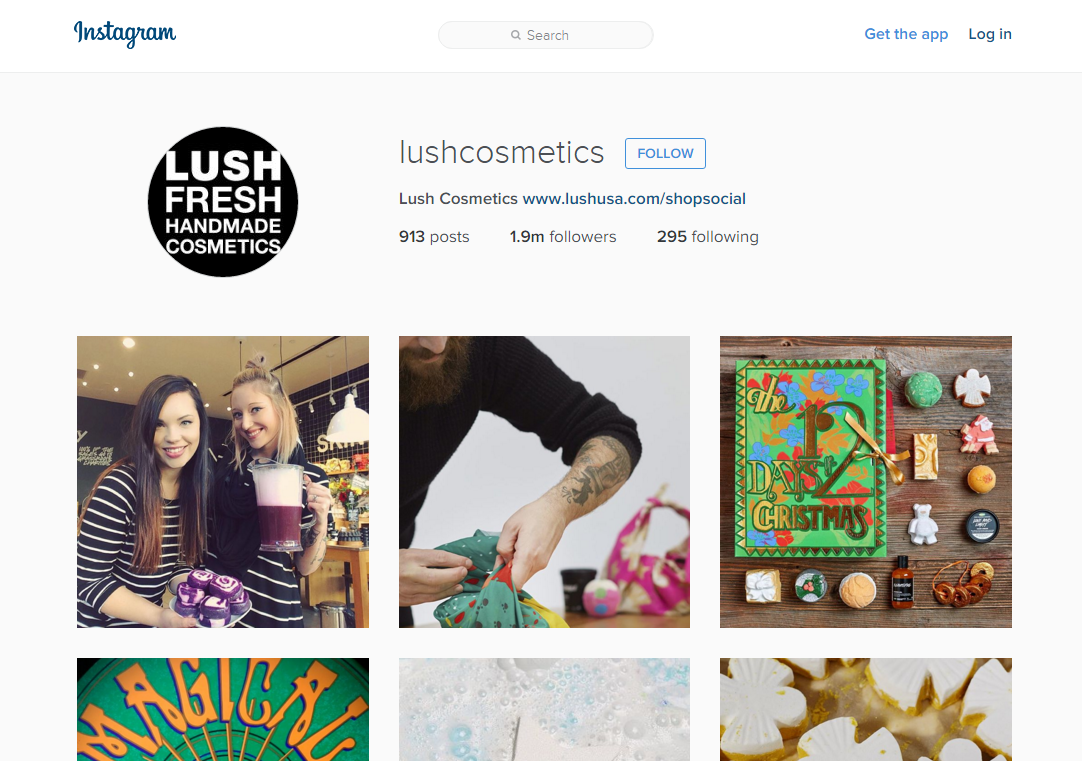People often overlook the power of Instagram for eCommerce.
Instagram is an incredibly easy way to reach customers effectively, because users can stumble upon your profile or photos and potentially proceed to your site.
If you’re just getting started on Instagram, check out the site’s guide on how to use the platform for business, which also includes some statistics and content strategy tips. But to make things easier, here are our top 10 tips on using Instagram for eCommerce.
1. Post your product images to get customers salivating
Browsing on Instagram is a bit like window shopping, minus the walking and bumping into people.
When you add a new product to your online store, your customers have to actively seek out your website or wait for your newsletter (if you have one) to see the item. If you Instagram it, your customers who follow you will see your product amidst their feed of #foodporn and sunset photos.
Instead of wasting time creating awesome product images specifically for your Instagram profile, create great product images that can be used across a variety of platforms. If you create good product images for your website, they should be suitable for your Instagram feed as well.
Eames Office and Grown Alchemist post beautiful product photos on their Instagrams from time to time:
![]()
Using a simple white background works really well because for one thing, it will match any website or platform design. This means you can use the same image multiple times and it won’t clash with any colour. If an Instagram user #regrams your photo, it won’t clash with their profile no matter what their particular colour scheme or style.
Using white also makes it really easy to manipulate the shape of your product image. By default, Instagram images are square. If your original product image isn’t a square, it won’t look awkward and disproportionate when you crop it to fit the Instagram frame.
![]()
Just make sure you include the name of the product and a link to where you can buy it, otherwise the post is less likely to drive traffic towards the product listing on your site.
2. Let your customers see themselves using your product with in-context photos
Using Instagram for eCommerce is great because it’s amazing for in-context photos! The problem, however, with using these photos as product images on your website is they can cause confusion as to what you’re actually selling. It’s not really a product image if it shows off five of your products or random items that just make your product look awesome.
That’s not to say that in-context photos aren’t effective; complementing a gorgeous bowl with tasty-looking granola is never a bad idea. But there is a place for these photos.
The good news is I can’t think of a better platform than your store’s Instagram feed. For some inspiration, take a look at what Frank Body and Nobody Denim do with their in-context photos:
![]()
Remember that Instagram is built off our love for visuals, so beautiful photos that make your products look beautiful are actually a must. In fact, limiting your feed to simple product images will make your Instagram look like an online store, when it’s meant to be a tool that’s used to build on your online store.
Show what your product can do or how it looks while worn. If you’re selling fashion, take photos of your product in a ‘lookbook’-style photo: Take a photo that makes your followers think, ‘I want that whole outfit’.
Complement your homewares or furniture with nice interiors to make your followers think, ‘I want that room’. In-context photos are supposed to sell your products by providing inspiration on what to do with them.
3. Give your brand a personality
Be silly, be lovely, be friendly.
Treat Instagram a bit like an exclusive look into your company. Post photos of your office to answer everyone’s ‘I wonder what it’s like to work there’ question. Treat your followers like your friends — this is one place you shouldn’t have to worry about being professional.
You can even go so far as to occasionally introduce your employees. Your employees will appreciate the recognition and your followers will get a glimpse of the faces behind one of their favourite online stores.
You can also show your production process, which can be particularly effective if you sell handmade goods. It’s honest and insightful and shows that you’re confident in what you’re selling. These photos have the same effect as a trailer for a movie: They create a sense of anticipation, which means your customers will be thinking about your product before you even release it.
Fictive Fingers and Skydog Jewelry are great at this:
![]()
If you’re doing a photo shoot of your products, why not Instagram the process? Use captions that mention ‘new products coming to you soon’ or ‘an exciting day shooting new arrivals’, similar to what Flynn and Sage and Clare did on their Instagrams.
4. Take your customers with you
If you have any work events or product hunts, or if your morning coffee looks perfect — Instagram it. Like I said before, don’t worry about being professional. People follow a business because they want to know more about it. Social media has allowed brands, particularly eCommerce stores, to build communities around their stores.
Loose Leaf and Oscar Wylee are both great at connecting with their customers.
5. Make your followers feel special
You’ll find your most loyal customers in your Instagram followers list. Give them exclusive previews of products and let them know of any promotions or events you’re having. They’re likely to show up!
You can even post 24-hour discount codes exclusively on Instagram. I would avoid the ‘follow, repost and win’ offers because they might end up spamming a lot of users’ feeds. Though you will gain brand recognition, the slight annoyance many people feel when they see promotional posts might give your store a negative brand image.
Here are two Instagram promotions from Marc Jacobs Fragrances and Equipment.
6. Use hashtags and get discovered
If you’re new to social media, a hashtag is a word or phrase written — with no spaces — after a hash sign (#). Hashtags began on Twitter and allowed tagged words and phrases to become searchable links. Clicking on the links would show users all the posts that used the same hashtags. You can now use hashtags on other social media platforms, Instagram included.
Hashtags can be used to group and organise photos. If you tag all of your photos with #yourbrandname or #shopbrandname (as Harper’s Bazaar did below), customers will start doing the same when they feature your products in their own photos. A great way to involve your customers with your brand is to repost their photos (make sure you give them credit!) and comment on/like their images.

You can also group your products. For example, if you carry both apparel and shoes, you can create a hashtag #yourbrandnameapparel and #yourbrandnameshoes. This makes it easier for customers to find specific types of products.
Use content hashtags to let people with similar interests find you. These hashtags can be used for locations, products, events and lifestyle. A good example is using the tag #fashion if you’re an online clothing store. People who are interested in fashion might find your profile when they’re browsing through the results under the #fashion tag.
You can also use hashtags to interact with people who have the same interests as you; start commenting on, liking and following users or posts with the tag #fashion.
That being said, make sure you only use hashtags that are relevant to your business, otherwise it’ll look like you’re spamming and desperately seeking followers. Don’t use anything along the lines of #tagsforlikes and #followforfollow — remember that you still need to maintain some element of professionalism as your Instagram is still a representation of your brand.
If you’ve got an event or a promotion, use hashtags to create excitement. Just make sure you don’t put punctuation in your hashtags (like exclamation marks), as doing so will let only the part of the word/phrase before the punctuation turn into a link.
![]()
7. Get creative with your photos
Using Instagram for eCommerce is the only time you should ever apply filters to photos of your products. However, you should avoid adding filters to the product photos I mentioned in tip #1, because those images should be accurate representations of the product — adding a filter will alter the colour.
ALSO ON THE PIXC BLOG: How to Take Awesome Product Photos with Your Smartphone
Leave the filters for in-context photos or any kind of random ‘take us with you’ photo. They can make your Instagram look artsier. Just make sure you don’t go overboard on the editing and end up with tacky photos.
Check out some of these editing apps if you’re after some cool filters:
PicFrame will let you place multiple photos in one frame. If you want to include any text, Overquick has some nice fonts and it’s really easy to use. If you need a rectangular shape to show off the product, try Whitagram or SquareFX and just add white space to either the top and bottom or the sides.
8. Post quotes — word spreads!
Who doesn’t love a bit of inspiration? A quote is often reposted, and yours can include a tag that links people to your Instagram profile.
Quotes can be funny or motivational, and they don’t have to be ones you came up with, although it’s good to attribute the quote if someone noteworthy said it. It’s also a good idea to create a theme for your quotes to keep them consistent — that way, people will begin to associate the theme with your brand.
Either use a photo or image you’ve taken and use a typography app (like Overquick, mentioned above) or go to Canva, set up a square px canvas and play around with all their colour, font, shape and icon options.
This typography from Sheike and T2 Tea just pops out in an Instagram feed.
9. Connect your Instagram to other social media platforms
Connecting your Instagram to your Twitter and Facebook draws attention to your Instagram account. Instead of posting the same image on your Instagram and Facebook/Twitter separately, post the photo to your Instagram and share it on Facebook/Twitter.
Interested customers will click the link and view your Instagram profile — then potentially follow you. The sharing option comes in the last step of the upload process, where you write your caption.

However, don’t repost every photo. Facebook isn’t as much of a microblogging tool as Instagram, which was created to allow people to constantly update their followers about the happenings of their everyday lives through imagery.
More personal and casual photos like those of the office, your employees and even your coffee should be left to Instagram. Sharing promotions and discounts will also take away the exclusivity of your Instagram. Product images and quotes are usually the most appropriate things to share.
A good idea is to learn who follows you on which platform and appeal to each audience. Remember that many customers will follow you on multiple platforms, so reposting is going to send them the same message three times.
10. Track your Instagram results
Like with any business tool, you should monitor your results to see the kinds of results you get using Instagram for eCommerce. You should consider which posts are best at driving traffic to your online store and use them more frequently.
Don’t worry, you don’t have to do this manually. There are a number of apps available that will help you track this kind of information, such as:
- SumAll
- Iconosquare
- Simply Measured
I hope these tips helped you set up your Instagram for eCommerce!
People on Instagram love to interact with brands, and they also love to buy! Make sure you create meaningful connections with your followers for loads of fun times and ever-increasing sales.









